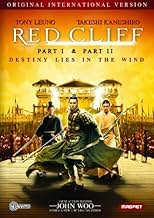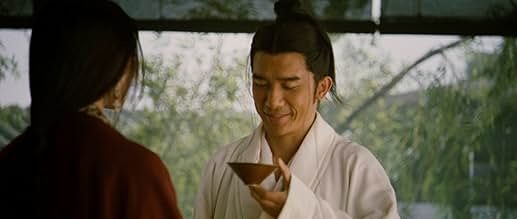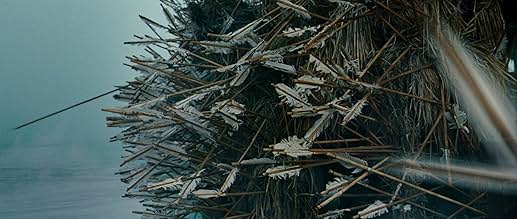Chi bi: Jue zhan tian xia
- 2009
- 2h 22min
CALIFICACIÓN DE IMDb
7.5/10
26 k
TU CALIFICACIÓN
Agrega una trama en tu idiomaSecond and final part of epic tale about a legendary battle that changed the course of China history.Second and final part of epic tale about a legendary battle that changed the course of China history.Second and final part of epic tale about a legendary battle that changed the course of China history.
- Dirección
- Guionistas
- Elenco
- Premios
- 8 premios ganados y 20 nominaciones en total
Tony Leung Chiu-wai
- Zhou Yu
- (as Tony Chiu Wai Leung)
Opiniones destacadas
After the fantastic first part, the second starts a little underwhelming. This film isn't quite as action packed as the first, instead building to the amazing finale. So there's about an hour and a half of each camp planning attacks and working to defeat the enemy. There are some really good parts here (especially how the rebels procure arrows) but it all pales in comparison to the massive, explosive finale. It's one of the best war scenes ever put to film and absolutely exciting.
Overall, this is a masterpiece of film and one of the best war movies of all time. It's well worth your time.
Overall, this is a masterpiece of film and one of the best war movies of all time. It's well worth your time.
Red Cliff, the film by John Woo based on the epic battle of Romance of the Three Kingdoms is divided into two parts. While the first was engaging in its depiction of such historical characters in Cao Cao, Zhuge Liang and Zhou Yu, the second is all about war itself, which can be a little daunting to some. But that is just how war is.
You see, war is not about a spontaneous fight between two opposing parties. It has nothing to do with sword wielding 'cling clang' or battle cries and fistfights. The distinction has to be made since war is by far a larger context than a battle, although war itself consists many. In Red Cliff II we will see what is at play when war is raged. It cannot be pretty can it? But it can as this is the romanticized version of history and on screen John Woo made it even prettier.
The cast is strong with Tony Leung Chiu-wai as viceroy Zhou Yu, Takeshi Kaneshiro as adviser Zhuge Liang and Zhang Fengyi as Cao Cao, to name just a few. The list is long. A good cast will more often than not up the aesthetical appeal to a movie. For the female audience, Tony Leung charms with his manly portrayal of Zhou Yu, and Takeshi Kaneshiro is always a pleasure to watch as he liven every scene with wit and humor. For the male audience, it is the childlike yet seriousness of Zhao Wei as Sun Shangxiang, and Lin Chi-ling's poise and compassion as Xiao Qiao that allures.
But can war really be pretty? If you think that killing each other is a good way to express beauty then perhaps you can be on the same page as the tyranny Cao Cao. In part 1, where the emphasis of battle was on land with a very elaborate tactic devised by Zhuge Liang, here in part 2 we witness the battle at sea, physically and psychologically.
Back to the main topic of war, it is crucial that victory must be sorted as numerous lives are heavily at stake, whether or not these lives are valued or not, be they as added numbers or as friends. In war the emphasis is on strategies and tactics to win. And on strategies and tactics, I guess we no doubt have to consult Sun Tzu's The Art of War and also take reference to The 36 Stratagems.
I can refer that the epic battle of Red Cliff has two points that stood out when referenced to The Art of War and that is The Attack By Fire and The Use Of Spies.
Recorded in the 36 stratagems is the use of the enemy's own spy to sow discord in the enemy's camp by Zhou Yu. This famous move is of correlation to The Art of War where it is stated as having converted spies, getting hold of the enemy's spies and using them for our own purposes. In war all can be done, there can be no holds barred because any weakness can be exploited by the enemy. Zhou Yu can be said to have brilliantly disposed off of Cao Cao's main strategic threat because Cao Cao slain both his most dependable generals who are most versed in sea battles.
When 50,000 has to fight 200,000, who could blame Zhou Yu for such tactics, especially when Cao Cao first provoked by sending dead soldiers across to Zhou Yu's side on wooden rafts, knowing that disease spread through this mean can greatly weaken his enemy.
The other account decisive of the battle of Red Cliff is the Chain Strategem, although modified by John Woo in its depiction, with the key in Lin Chi-ling's character, Xiao Qiao.
It is interesting to sit through 141 minutes witnessing a romanticized version of John Woo's Red Cliff. Personally I didn't feel that it was long, however to some who wanted to see a Lord of the Ring's type battle on screen could be disappointed.
Sun Tzu's The Art of War states that the general who wins a battle makes many calculations in his temple before the war is fought. The general who loses a battle makes but a few calculations before hand. Thus do many calculations lead to victory, and few calculations to defeat: how much more no calculation at all! It is by attention to this point that I can foresee who is likely to win or lose.
The point of war however is that in war everybody loses. This should be what John Woo's Red Cliff is trying to tell us. I agree wholeheartedly with water in my eyes.
You see, war is not about a spontaneous fight between two opposing parties. It has nothing to do with sword wielding 'cling clang' or battle cries and fistfights. The distinction has to be made since war is by far a larger context than a battle, although war itself consists many. In Red Cliff II we will see what is at play when war is raged. It cannot be pretty can it? But it can as this is the romanticized version of history and on screen John Woo made it even prettier.
The cast is strong with Tony Leung Chiu-wai as viceroy Zhou Yu, Takeshi Kaneshiro as adviser Zhuge Liang and Zhang Fengyi as Cao Cao, to name just a few. The list is long. A good cast will more often than not up the aesthetical appeal to a movie. For the female audience, Tony Leung charms with his manly portrayal of Zhou Yu, and Takeshi Kaneshiro is always a pleasure to watch as he liven every scene with wit and humor. For the male audience, it is the childlike yet seriousness of Zhao Wei as Sun Shangxiang, and Lin Chi-ling's poise and compassion as Xiao Qiao that allures.
But can war really be pretty? If you think that killing each other is a good way to express beauty then perhaps you can be on the same page as the tyranny Cao Cao. In part 1, where the emphasis of battle was on land with a very elaborate tactic devised by Zhuge Liang, here in part 2 we witness the battle at sea, physically and psychologically.
Back to the main topic of war, it is crucial that victory must be sorted as numerous lives are heavily at stake, whether or not these lives are valued or not, be they as added numbers or as friends. In war the emphasis is on strategies and tactics to win. And on strategies and tactics, I guess we no doubt have to consult Sun Tzu's The Art of War and also take reference to The 36 Stratagems.
I can refer that the epic battle of Red Cliff has two points that stood out when referenced to The Art of War and that is The Attack By Fire and The Use Of Spies.
Recorded in the 36 stratagems is the use of the enemy's own spy to sow discord in the enemy's camp by Zhou Yu. This famous move is of correlation to The Art of War where it is stated as having converted spies, getting hold of the enemy's spies and using them for our own purposes. In war all can be done, there can be no holds barred because any weakness can be exploited by the enemy. Zhou Yu can be said to have brilliantly disposed off of Cao Cao's main strategic threat because Cao Cao slain both his most dependable generals who are most versed in sea battles.
When 50,000 has to fight 200,000, who could blame Zhou Yu for such tactics, especially when Cao Cao first provoked by sending dead soldiers across to Zhou Yu's side on wooden rafts, knowing that disease spread through this mean can greatly weaken his enemy.
The other account decisive of the battle of Red Cliff is the Chain Strategem, although modified by John Woo in its depiction, with the key in Lin Chi-ling's character, Xiao Qiao.
It is interesting to sit through 141 minutes witnessing a romanticized version of John Woo's Red Cliff. Personally I didn't feel that it was long, however to some who wanted to see a Lord of the Ring's type battle on screen could be disappointed.
Sun Tzu's The Art of War states that the general who wins a battle makes many calculations in his temple before the war is fought. The general who loses a battle makes but a few calculations before hand. Thus do many calculations lead to victory, and few calculations to defeat: how much more no calculation at all! It is by attention to this point that I can foresee who is likely to win or lose.
The point of war however is that in war everybody loses. This should be what John Woo's Red Cliff is trying to tell us. I agree wholeheartedly with water in my eyes.
Red Cliff 2 is a good action pic. Even though we already know the result the movie still manages to keep it exciting and suspenseful. Granted artistic license were probably taken with the story but who cares, its a movie not a historical documentary.
That being said there were a few parts of the movie that defied belief. The shu princess as a spy and how easily she manages to accomplish her mission. The final battle was also some what disappointing, too much CG explosions.
But the biggest thing for me is ........... its NOT a propaganda movie. Thank you John Woo for that. I was expecting a "we must stand together and sacrifices must be made for the country to be united and prosperous" message that we have been getting from most of the Chinese "historical" epics. There wasn't any :) Good movie, good visuals, good acting.
That being said there were a few parts of the movie that defied belief. The shu princess as a spy and how easily she manages to accomplish her mission. The final battle was also some what disappointing, too much CG explosions.
But the biggest thing for me is ........... its NOT a propaganda movie. Thank you John Woo for that. I was expecting a "we must stand together and sacrifices must be made for the country to be united and prosperous" message that we have been getting from most of the Chinese "historical" epics. There wasn't any :) Good movie, good visuals, good acting.
The battle of the Red Cliff, which is the climax from the first half of "Romance of the Three Kingdom" by Luo Guanzhong is perhaps the most spectacular war story in all of Asia. Until the outbreak of Russo-Japanese war, it certainly was one of the biggest battle of the region, and perhaps the biggest in terms of numbers of people involved.
Director John Woo assembled an international talent of actors to create this one of a kind epic movie. He's described it as 50% fictional, but he must have put lot of thoughts into the fiction part, because all the filling that he puts in works to enhance the story, and brings excitement to each scene.
The story is somewhat long, and for ones who are not familiar with the historic saga of this battle, may feel that it's overly protracted, but the movie was geared mainly for the Chinese audience (China bankrolled the film), who are intimately familiar with the characters described in this story. I'm sure many went to the theaters to see their favorite heroes come to life.
The casting is done exceptionally well, as they convey the authority of the characters they are playing. Clever casting from different countries around Asia (China, Korea, Japan, and Taiwan) ensured that people of those countries will not see it as foreign film, but one of their own.
This certainly is the best warrior based movie to come out of China, and even for the jaded director John Woo, the greatest masterpiece. Superbly crafted movie, and equally superb story telling, captures all the highlights of the Battle of the Red Cliff.
Part 1 was good, but this blows the doors off of Part 1.
One of the greatest movie to come out of Asia.
Director John Woo assembled an international talent of actors to create this one of a kind epic movie. He's described it as 50% fictional, but he must have put lot of thoughts into the fiction part, because all the filling that he puts in works to enhance the story, and brings excitement to each scene.
The story is somewhat long, and for ones who are not familiar with the historic saga of this battle, may feel that it's overly protracted, but the movie was geared mainly for the Chinese audience (China bankrolled the film), who are intimately familiar with the characters described in this story. I'm sure many went to the theaters to see their favorite heroes come to life.
The casting is done exceptionally well, as they convey the authority of the characters they are playing. Clever casting from different countries around Asia (China, Korea, Japan, and Taiwan) ensured that people of those countries will not see it as foreign film, but one of their own.
This certainly is the best warrior based movie to come out of China, and even for the jaded director John Woo, the greatest masterpiece. Superbly crafted movie, and equally superb story telling, captures all the highlights of the Battle of the Red Cliff.
Part 1 was good, but this blows the doors off of Part 1.
One of the greatest movie to come out of Asia.
With the cast established, their motivations solidified, the stage set and the first volleys already thrown in the original, John Woo is able to just sit back, relax, and make the thoroughly indulgent epic action picture he always wanted in its sequel. Where the first film thematically leans more in the direction of theology and politics, backed by a brief taste of large-scale military maneuvers, this follow-up is a full-gale blast of battlefield planning and dramatic execution. History buffs may grimace at a few of its flashier moments, like the warrior who uses his spear to pole vault over enemy battalions, but those are rare enough to write off as passing fits of eccentricity from a director who's not always known for his realism. Besides, the real sizzle lies with the world-class, hour long battle scene that closes the picture - and the obscene amount of fascinating war maneuvers seen therein. It's the mother of all fight scenes, an intense, unrelenting thrill ride the likes of which hasn't been seen from the west in decades, if ever. And, as Woo addresses one of my biggest complaints about the first Red Cliff - the generic, evil-for-the-fun-of-it enemy commander who's admirably rounded out in a few powerful scenes - it's ultimately an even better effort than its predecessor. A thrilling, intense, large-scale classic that makes for one hell of a payoff.
¿Sabías que…?
- TriviaA form of Wilhem scream can be heard when the first Zhou Yu's fire ship attacked Cao Cao's navy during the final battle. The scream was used when the on fire straw struck the first navy soldier.
- ErroresWhen Pit first takes an arrow after learning that Sun Shangxiang was Piggy, the arrow is clearly in the middle of the second layer of his armor, yet on the next shot, the arrow is now in the top layer of the armor.
- ConexionesFollows Chi bi (2008)
Selecciones populares
Inicia sesión para calificar y agrega a la lista de videos para obtener recomendaciones personalizadas
- How long is Red Cliff II?Con tecnología de Alexa
Detalles
- Fecha de lanzamiento
- Países de origen
- Sitios oficiales
- Idioma
- También se conoce como
- Red Cliff II
- Productoras
- Ver más créditos de la compañía en IMDbPro
Taquilla
- Presupuesto
- USD 80,000,000 (estimado)
- Total a nivel mundial
- USD 120,432,178
- Tiempo de ejecución2 horas 22 minutos
- Color
- Mezcla de sonido
- Relación de aspecto
- 2.39 : 1
Contribuir a esta página
Sugiere una edición o agrega el contenido que falta




























